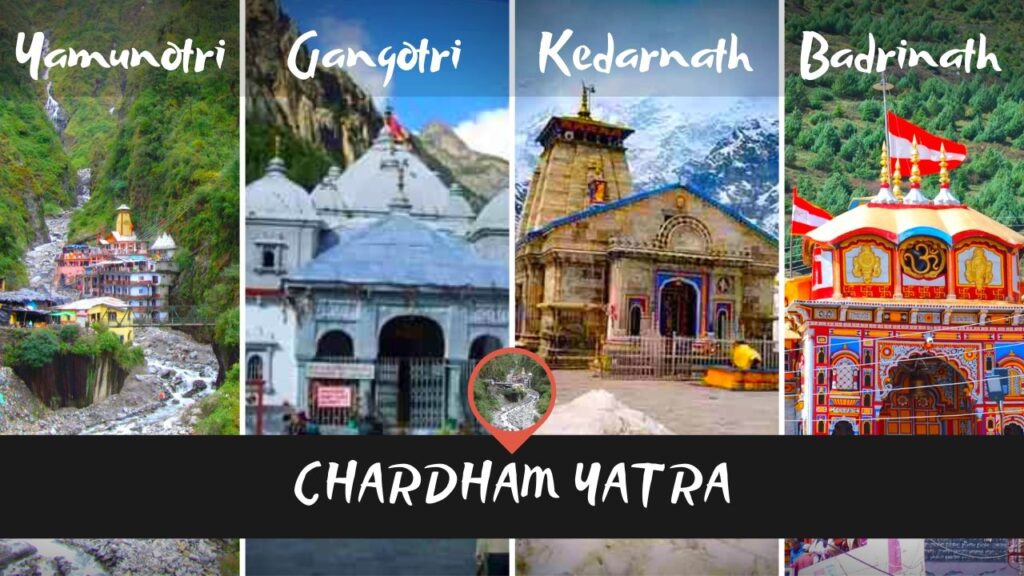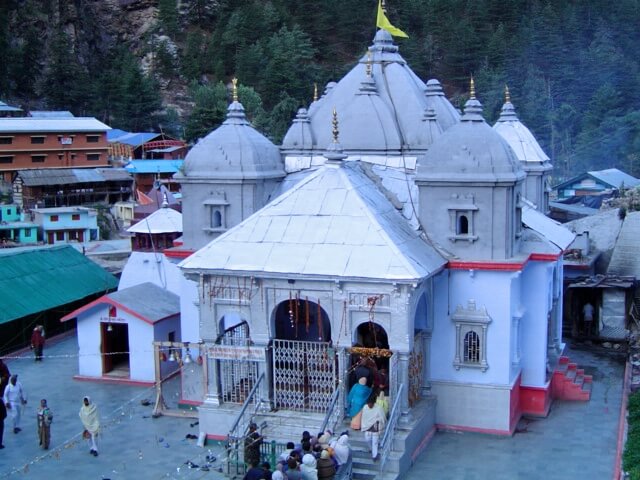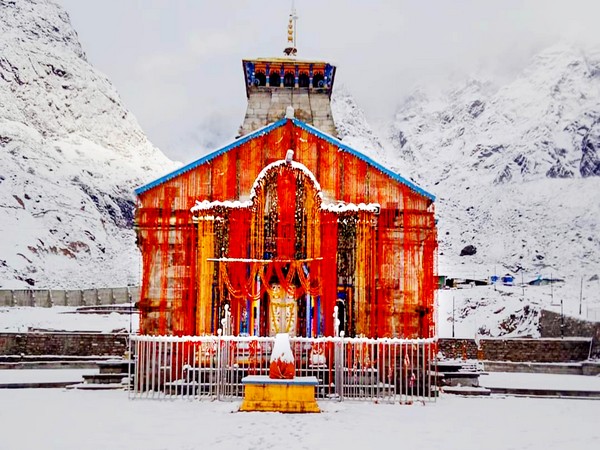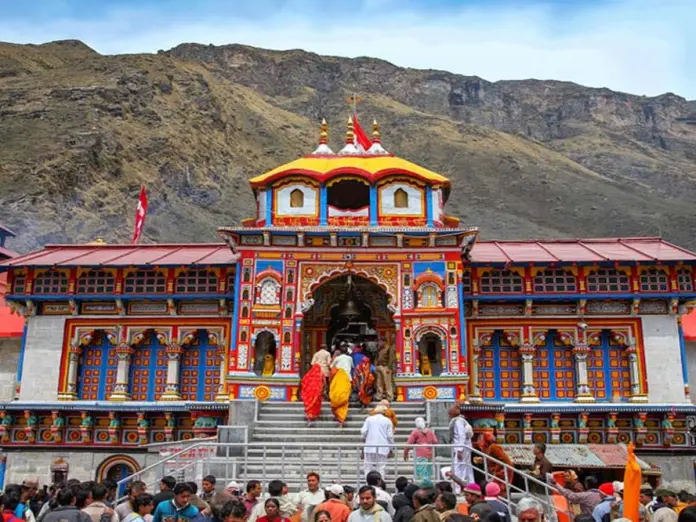
Chardham Yatra Opening Date 2023
• Yamunotri Temple Opening Date 2023 – Akshaya Tritiya April 22, 2023, Friday. (अक्षय तृतीया22 अप्रैल 2023)
• Gangotri Temple Opening Date 2023 – Akshaya Tritiya April 22 2023,(अक्षय तृतीया22 अप्रैल 2023)
• Kedarnath Temple Opening Date 2023 – 25th April 2023 Time 6:20am
• Badrinath Temple Opening Date 2023 – 27th April 2023 Time 7:10am
Chardham Yatra Closing Date 2023
• Yamunotri Temple Closing Date 2023 – 14 November 2023
• Gangotri Temple Closing Date 2023 – 13 November 2023
• Kedarnath Temple Closing Date 2023 – 14 November 2023
• Badrinath Temple Closing Date 2023 – 21 November 2023
CHARDHAM ROAD MAP (YAMUNOTRI, GANGOTRI, KEDARNATH AND BADRINATH)
Yamunotri Temple

Yamunotri Temple is situated in the western region of Garhwal Himalayas at an altitude of 3,291 metres (10,797 ft) in Uttarakhand distric, Uttarakhand. It’s just 129 km from Uttarkashi, the main district headquarters. The temple is dedicated to Goddess Yamuna, and has a black marble idol of the goddess.The Yamunotri temple is a full day’s journey from Uttarakhand’s main towns — Uttarkashi, Rishikesh, Haridwar or Dehradun. The actual temple is only accessible by a 13 kilometres (8.1 mi) trek from the town of Hanuman Chatti and a 6 kilometres (3.7 mi) walk from Janki Chatti; horses or palanquins are available for rent. The hike from Hanuman Chatti to Yamunotri takes in views of a number of waterfalls. There are two trekking routes from Hanuman Chatti to Yamunotri; the one along the right bank proceeds via the Markandeya Tirth, where the sage Markandey wrote the Markandeya. The other route–which lies on the left bank of the river–goes via Kharsali, from where Yamunotri is a five or six hours climb.
History
Yamunotri temple has a shrine dedicated to the goddess. There is also an 18th-century temple at Gangotri; it was built by Garhwal Naresh Pratap Shah; it was damaged and re-innovated in the 19th century. The temple has been destroyed twice by snow and floods before being rebuilt. It is located on the backdrop of Bandarpunch. The temple is part of the revered Char Dham pilgrimage circuit.
Temple and vicinity
The temple opens on Akshaya Tritiya. (May) and closes on Yama Dwitiya. (the second day after Diwali, November) for the winter.A little ahead is the actual source of the river Yamuna, which is at an altitude of about 4,421 metres (14,505 ft) approximately. Two hot springs are also present at Yamunotri, offering relief to tired hikers at a height of 3,292 metres (10,801 ft). Surya Kund has boiling hot water, while Gauri Kund has tepid water suitable for bathing The spring water is said to be hot enough to cook rice and potatoes. Lodging at the temple itself is limited to a few small ashrams . and guest-houses. Ritual duties, such as the making and distribution of Prasad (sanctified offerings) and the supervision of pujas (ritual venerations), are performed by the Uniyal family of pujaris (priests). Unique aspects of ritual practice at the site include hot springs, where raw rice is cooked and made into prasad.
Gangotri

Gangotri is a town and a Nagar Panchayat (municipality) in Uttarkashi district Uttarkashi distric in the state of Uttarakhand, India. It is 99 km from Uttarkashi, the main district headquarter. It is a Hindu pilgrim town on the banks of the river Bhagirathi – the origin of the river Ganges. The town is located on the Greater Himalayan Range, at a height of 3,100 metres (10,200 ft). According to popular Hindu legend, Goddess Ganga descended here when Lord Shiva released the mighty river from the locks of his hair.
Bhagirathi River and Himalayas in Gangotri, Uttarakhand
Gangotri significance
Gangotri is one of the four sites in the Chota Char Dham pilgrimage circuit. It is also the origin of the Ganges river and seat of the goddess Ganga. The river is called Bhagirathi at the source and acquires the name Ganga (the Ganges) from Devprayag onwards where it meets the Alaknanda. The origin of the holy river is at Gaumukh, set in the Gangotri Glacier, and is a 19 km trek from Gangotri. The original Gangotri Temple was built by the Nepalese general Amar singh Thapa. The temple is closed from Diwali day every year and is reopened on Akshaya Tritiya. During this time, the idol of the goddess is kept at Mukhba village, near Harsil. Ritual duties of the temple are supervised by the semwal family of pujaris. These pujaris hail from Mukhba village.
Gangotri Temple
A temple dedicated to Goddess Ganga is located near a sacred stone where King Bhagiratha worshipped Lord Shiva. According to Hindu culture, Goddess Ganga took the form of a river to absolve the sins of King Bhagiratha’s predecessors, following his severe penance of several centuries. Bhagiratha Shila is a sacred slab where king Bhagiratha meditated. Ganga is believed to have touched earth at this spot. According to another legend, Pandavas performed the great ‘Deva Yagna’ here to atone the deaths of their kinsmen in the epic battle of Mahabharata. Hindus believe that performing the ancestral rites on the banks of Bhagirathi frees the spirit of the ancestor from the cycle of rebirth and a holy dip in its waters cleanses sins committed in the present also past births.
The Gangotri temple opens on the auspicious day of Akshaya Tritiya which falls in the month of May and closes on Yama Dwitiya or Bhai Dooj which falls in the month of November. The Gangotri temple remains closed for the rest of six months. The Goddess shifts to the village Mukhba during the winter months. In the month of May, Ganga Dussehra is celebrated with great fanfare as the day of the birth of Ganga.
Demographics
According to the 2011 census of India, there are total 47 families residing in Gangotri. The total population of Gangotri is 110 out of which 97 are males and 13 are females. The literacy rate of Gangotri is 99.1%. The entire population of Gangotri identifies as Hindu.
Kedarnath Temple

Kedarnath Temple (Sanskrit: केदारनाथ मंदिर, IAST : Kēdāranātha Mandira, lit. ’temple of the God of the field’) is a Hindu temple, one of the twelve jyotirlinga of Shiva. The temple is located on the Garhwal Himalayan range near the Mandakini river, in the state of Uttarakhand, India. Due to extreme weather conditions, the temple is open to the general public only between the months of April (Akshava Tritiya) and November (Kartik Purnima, the autumn full moon). During the winters, the vigraha (deity) of the temple is carried down to Ukhimath to be worshipped for the next six months. Kedarnath is seen as a homogenous form of Shiva, the ‘Lord of Kedarkhand’, the historical name of the region.

The temple is not directly accessible by road and has to be reached by a 22 kilometres (14 mi) uphill trek from Gaurikund. Pony, mule and manchan service is available to reach the temple. According to Hindu legends, the temple was initially built by the Pandavas, and is one of the twelve Jyotirlingas, the holiest Hindu shrines of Shiva. The Pandavas were supposed to have pleased Shiva by doing penance in Kedarnath. The temple is one of the four major sites in India’s Chota Char Dham pilgrimage of Northern Himalayas and is the first of the Panch Kedar pilgrimage sites. This temple is the highest among the 12 Jyotirlingas. It is one of the 275 paadal petra sthalams expounded in the Tevaram, a sacred Tamil Shaivite text written during the 6th and 7th centuries by 63 saints called Nayanars. This temple is sung of by Thirugnanasambandar, Appar, Sundarar and Sekkizhar in their Tevaram texts.
Kedarnath was the worst affected area during the 2013 flash floods in North India. The temple complex, surrounding areas, and Kedarnath town suffered extensive damage, but the temple structure did not suffer any major damage, apart from a few cracks on one side of the four walls which was caused by the flowing debris from the higher mountains. A large rock among the debris acted as a barrier, protecting the temple from the flood. The surrounding premises and other buildings in the market area were heavily damaged.
History and legends of origin
The Pandavas visit Kedarnath after the Mahabharata War
At a height of 3,583 m (11,755 ft), 223 km (139 mi) from Rishikesh, on the shores of Mandakini river, a tributary of Ganga, is a stone edifice of unknown date. It is not certain who built the original Kedarnath temple and when. The name “Kedarnath” means “the lord of the field”: it derives from the Sanskrit words kedara (“field”) and natha (“lord”). The text Kashi Kedara Mahatmya states that it is so called because “the crop of liberation” grows here.
Many folk legends related to the Garhwal region, Lord Shiva and the creation of the Panch Kedar temples are narrated.

A folk legend about Panch Kedar relates to the Pandavas, the heroes of the Hindu epic Mahabharata. The Pandavas defeated and slew their cousins — the Kauravas in the epic Kurukshetra war. They wished to atone for the sins of committing fratricide (gotra hatya) and Brahmanahatya (killing of Brahmins — the priest class) during the war. Thus, they handed over the reins of their kingdom to their kin and left in search of the lord Shiva and to seek his blessings. First, they went to the holy city of Varanasi (Kashi), believed to be Shiva’s favourite city and known for its Kashi Vishwanath Temple. But, Shiva wanted to avoid them as he was deeply incensed by the death and dishonesty at the Kurukshetra war and was, therefore, insensitive to Pandavas’ prayers. Therefore, he assumed the form of a bull (Nandi) and hid in the Garhwal region.
Not finding Shiva in Varanasi, the Pandavas went to Garhwal Himalayas Bhima, the second of the five Pandava brothers, then standing astride two mountains started to look for Shiva. He saw a bull grazing near Guptakashi (“hidden Kashi” — the name derived from the hiding act of Shiva). Bhima immediately recognized the bull to be Shiva. Bhima caught hold of the bull by its tail and hind legs. But the bull-formed Shiva disappeared into the ground to later reappear in parts, with the hump raising in Kedarnath, the arms appearing in Tungnath, the face showing up at Rudranath, the nabhi (navel) and stomach surfacing in Madhyamaheshwar and the hair appearing in Kalpeshwar. The Pandavas pleased with this reappearance in five different forms, built temples at the five places for venerating and worshipping Shiva.
Connectivity
Nearest Airport: Dehradun
Nearest Railway Station: Rishikesh
Badrinath Temple

Badarinath or Badarinarayana Temple is a Hindu temple dedicated to Vishnu. It is situated in the town of Badrinath in Uttarakhand, India. The temple is also one of the 108 Divya Desams dedicated to Vishnu—holy shrines for Vaishnavas—who is worshipped as Badrinath. It is open for six months every year (between the end of April and the beginning of November), because of extreme weather conditions in the Himalayan region. The temple is located in Garhwal hill tracks in Chamoli district along the banks of Alaknanda River. It is one of the most visited pilgrimage centers of India, having recorded 2.8 million (28 lakh) visits in just 2 months in 2022. It is one of the Char Dham pilgrimage sites.
The image of the presiding deity worshipped in the temple is a 1 ft (0.30 m), the black granite deity of Vishnu in the form of Badrinarayan. The deity is considered by many Hindus to be one of eight svayam vyakta kshetras, or self-manifested deities of Vishnu.
Mata Murti Ka Mela, which commemorates the descent of river Ganges on mother earth, is the most prominent festival celebrated in the Badrinath Temple. Although Badrinath is located in North India, the head priest, or Rawal, is traditionally a Nambudiri Brahmin chosen from the South Indian state of Kerala. The temple was included in the Uttar Pradesh state government Act No. 30/1948 as Act no. 16,1939, which later came to be known as Shri Badarinath and Shri Kedarnath Mandir Act. The committee nominated by the state government administers both the temples and has seventeen members on its board.
Devotees at the Badrinath Temple in October 2022
The temple is mentioned in ancient religious texts like Vishnu Purana and Skanda Purana. It is glorified in the Naalayira Divya Prabandham, an early medieval Tamil l canon of the Alvar saints from the 6th–9th centuries CE.
Location, architecture, and shrines
Tapt Kund hot springs next to Badrinath Temple, enclosed inside bath house
The temple is located in Garhwal hill tracts along the banks of the Alaknanda River in Chamoli district in Uttarakhand. The hill tracts are located 3,133 m (10,279 ft) above the mean sea level.The Nar Parbat mountain is located opposite to the temple, while the Narayana Parbat is located behind the Neelkanth peak.
Adi Shankara established Badrinath as a pilgrimage site in the ninth century. The temple has three structures: the Garbhagriha (sanctum), the Darshan Mandapa (worship hall), and Sabha Mandapa (convention hall). The conical-shaped roof of the sanctum, the garbhagriha, is approximately 15 m (49 ft) tall with a small cupola on top, covered with a gold gilt roof. The facade is built of stone and has arched windows. A broad stairway leads up to the main entrance, a tall, arched gateway. Just inside is a mandap, a large, pillared hall that leads to the sanctum, or main shrine area. The walls and pillars of the hall are covered with intricate carvings.
The main shrine houses the 1 ft (0.30 m) Shaligram (black stone) deity of Badrinarayana, which is housed in a gold canopy under a Badri Tree. The deity of Badrinarayana shows Him holding a Shankha (conch) and a Chakra (wheel) in two of His arms in a lifted posture and the other two arms resting on His lap in a Yogamudra (Padmasana) posture. The sanctum also houses images of the god of wealth—Kubera, sage Narada, Uddhava, Nara and Narayana. There are fifteen more images that are also worshipped around the temple. These include that of Lakshmi (the consort of Vishnu), Garuda (the vahana of Narayan), and Navadurga, the manifestation of Durga in nine different forms. The temple also has shrines of Lakshmi Narasimhar and for saints Adi Shankara (CE 788-820), Nar and Narayan, Ghantakarna, Vedanta Desika and Ramanujacharya. All the deities of the temple are made of black stone.
The Tapt Kund, a group of hot sulphur springs just below the temple, are considered to be medicinal; many pilgrims consider it a requirement to bathe in the springs before visiting the temple. The springs have a year-round temperature of 55 °C (131 °F), while outside temperature is typically below 17 °C (63 °F) all year round. The two water ponds in the temple are called Narad Kund and Surya Kund.
History
There is no historical record about the temple, but there is a mention of the presiding deity Badrinath in Vedic scriptures (c. 1750–500 BCE). According to some accounts, the shrine was worshipped in some form in the Vedic period. brightly painted facade which is atypical of Buddhist temples leads to the argument. Other accounts relate that it was originally established as a pilgrimage site by Adi Shankara in the ninth century. It is believed that Shankara resided in the place for six years from CE 814 to 820. He resided six months in Badrinath and the rest of the year in Kedarnath. Hindu followers assert that he discovered the deity of Badrinath in the Alaknanda River and enshrined it in a cave near the Tapt Kund hot springs. A traditional story asserts that Shankara expelled all the Buddhists in the region with the help of the Parmar ruler king Kanak Pal, however this might be fictitious and very recent because historically, Parmars did not rule the region contemporary to Shankaracharya. The hereditary successors of the king governed the temple and endowed villages to meet its expenses. The income from a set of villages on the route to the temple was used to feed and accommodate pilgrims. The Parmar rulers held the title “Bolanda Badrinath”, meaning speaking Badrinath. They had other titles, including Shri 108 Basdrishcharyaparayan Garharaj Mahimahendra, Dharmabibhab, and Dharamarakshak Sigamani.
The throne of Badrinath was named after the presiding deity; the king enjoyed ritual obeisance by the devotees before proceeding to the shrine. The practice was continued until the late 19th century. During the 16th century, the King of Garhwal moved the murti to the present temple. When the state of Garhwal was divided, the Badrinath temple came under British rule but the king of Garhwal continued as the chairman of the management committee. The selection of priest is done after consultation between Garhwal and Travancore royal families.
The temple has undergone several major renovations due to its age and damage by an avalanche. In the 17th century, the temple was expanded by the Kings of Garhwal. After significant damage during the great 1803 Garhwal earthquake, it was largely rebuilt by the King of Jaipur. It was still under renovation as late as the 1870s but these were completed by the time of the First World War. At that time,the town was still small, consisting of only the 20-odd huts housing the temple’s staff, but the number of pilgrims was usually between seven and ten thousand. The Kumbha Mela festival held every twelve years raised the number of visitors to 50,000. The temple also enjoyed revenue from the rents owed to it by various villages bequeathed by various rajas.
During 2006, the state government announced the area around Badrinath as a no construction zone to curb illegal encroachment.
Yamunotri Dham Route Map
It is the westernmost shrine of Garhwal region. Yamunotri is the origin of river Yamuna, this place is famous for the temple of Goddess Yamuna and the holy thermal springs at Janki Chatti. The temple of Yamuna was constructed by Maharaja Pratap Shah of Tehri Garhwal.
Important Place to Visit : Yamunotri Temple, Saptarishi Kund, Surya Kund, Divya Shila, HanumanChatti, Kharsali.
Rishikesh to Narendranagar 20 kms, Narendranagar to Chamba 43 kms, Chamba to Brahmkhal 15 kms, Brahmkhal to Barkot 40 kms, Barkot to Sayana Chatti 27 kms, Sayana Chatti to Hanuman Chatti 6 kms, Hanuman Chatti to Phool Chatti 5 kms, Phool Chatti to Janki Chatti 3 kms, Janki Chatti to Yamunotri 6 kms.
Gangotri Dham Route Map
The shrine of Gangotri is elevation of 3200 mt above sea level in Uttarakashi, the place where thousands of devotee pay their visit to wash away their sins in the urge of salvation. The holy river Ganga flows with purity and peace.
Important Place to Visit : Bhojbasa, Gangnani, Kedartal, Gaumukh, Gangotri Temple, Bhaironghati, Jalmagna Shivlinga, Tapovan.
Rishikesh to Tehri 75 kms, Tehri to Uttarkashi 123 kms, Uttarkashi to Bhatwari 31 kms, Bhatwari to Gangnani 15 kms, Gangnani to Harsil 31 kms, Harsil to Gangotri 25 kms
Kedarnath Dham Route Map
This temple is situated at an altitude of 3584 m above the sea level, followed by the river Mandakini. Kedarnath is one of the 12 Jyotirling of Lord Shiva. Kedarnath is very easy to reach, the routes of Kedarnath is good in condition. The Famous Jyotirling of Lord Shiva is must visited place where Lord Shiva showing his presence as a fiery column of light.
Important Place to Visit : Gandhi Sarovar, Phata, Son Prayag, Triyugi Narayan Temple, Chandrapuri, Kalimath, Vasuki Tal, Shankaracharya Samadhi, Gaurikund.
Rishikesh to Devaprayag 74 kms, Devprayag to Srinagar 34 kms, Srinagar to Rudraprayag 35 kms, Rudrapryag to Tilwara 9 kms, Tilwara to Agastamuni 10 kms, Agastamuni to Kund 15 kms, Kund to Guptkashi 5 kms, Guptkashi to Phata 11 kms, Phata to Rampur 9 kms, Rampur to SonPrayag 3 kms, SonPrayag to Gaurikund 5 kms,
Kedarnath NEW ROUTE after 2013 Flood
Gaurikund to Jungle Chatti 4 kms, Jungle Chatti to Bheembali 3 kms, Bheembali to Lincholi 4 kms, Lincholi to Kedarnath 4 kms
Badrinath Dham Route Map
It is elevated at an altitude of 3133 mt above sea level, from the left of river Alakhnanda. This sacred place is devoted to Lord Vishnu, legends says that Lord Vishnu maditated at this place.
Important Place to Visit : Pandukeshwar, Yogadhyan Badri Temple, Mana Village, Satopanth Lake, Tapta Kund, Neelkanth Peak, Charan Paduka, Mata Murti Temple, Narad Kund, Bheem Pul, Ganesh Cave, Brahma Kapal, Sheshnetra, Vyas Cave etc.
Haridwar to Rishikesh 24 kms, Rishikesh to Devprayag 74 kms, Devprayag to Srinagar 34 kms, Srinagar to Rudraprayag 33 kms, Rudraprayag to Karnaprayag 31 kms, Karnaprayag to Nandprayag 21 kms, Nandprayag to Chamoli 10 kms, Chamoli to Joshimath 48 kms, Joshimath to Badrinath 42 kms
CHAR DHAM YATRA PACKAGE SERVICES 2023
We give complete services of Chardham Yatra Tour Package 2023, like we arrange kedarnath helicopter ticket, chardham by helicopters, hotel, camps, bus, chardham taxi or car etc.
• Chardham Yatra Taxi/Car Service: We offer Chardham Yatra Taxi Service, Chardham taxi/bus/car rental service as per your requirements.
• Chardham Yatra Helicopter Service: We offer Chardham helicopter services for Gangotri, Yamunotri, Badrinath and Kedaranth. And we offer kedarnath helicopter ticket booking.
• Chardham Hotels Booking: We booking the Chardham route hotels, lodges, guest houses, resorts and other accommodation.
• Chardham Camps: We are booking Chardham camp accommodation in spacious all weather proof swiss camps. All Chardham Camps Luxury Camps near Yamunotri, Gangotri and Kedarnath.

